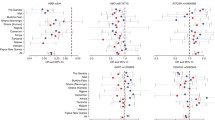Abstract
Functional studies have demonstrated an interaction between the stimulatory G protein alpha subunit (G-alpha-s) and the malaria parasite at a cellular level. Obstruction of signal transduction via the erythrocyte G-alpha-s subunit reduced invasion by Plasmodium falciparum parasites. We sought to determine whether this signal pathway had an impact at the disease level by testing polymorphisms in the gene encoding G-alpha-s (GNAS) for association with severe malaria in a large multi-centre study encompassing family and case–control studies from The Gambia, Kenya and Malawi, and a case–control study from Ghana. We gained power to detect association using meta-analysis across the seven studies, with an overall sample size approximating 4,000 cases and 4,000 controls. Out of 12 SNPs investigated in the 19 kb GNAS region, four presented signals of association (P < 0.05) with severe malaria. The strongest single-locus association demonstrated an odds ratio of 1.13 (1.05–1.21), P = 0.001. Three of the loci presenting significant associations were clustered at the 5-prime end of the GNAS gene. Accordingly, haplotypes constructed from these loci demonstrated significant associations with severe malaria [OR = 0.88 (0.81–0.96), P = 0.005 and OR = 1.12 (1.03–1.20), P = 0.005]. The evidence presented here indicates that the influence of G-alpha-s on erythrocyte invasion efficacy may, indeed, alter individual susceptibility to disease.



Similar content being viewed by others
References
Adams JH, Blair PL, Kaneko O, Peterson DS (2001) An expanding ebl family of Plasmodium falciparum. Trends Parasitol 17:297–299
Aidoo M, Terlouw DJ, Kolczak MS, McElroy PD, ter Kuile FO, Kariuki S, Nahlen BL, Lal AA, Udhayakumar V (2002) Protective effects of the sickle cell gene against malaria morbidity and mortality. Lancet 359:1311–1312
Cowman AF, Crabb BS (2006) Invasion of red blood cells by malaria parasites. Cell 124:755–766
Gonzalez JM, Portillo MC, Saiz-Jimenez C (2005) Multiple displacement amplification as a pre-polymerase chain reaction (pre-PCR) to process difficult to amplify samples and low copy number sequences from natural environments. Environ Microbiol 7:1024–1028
Harrison T, Samuel BU, Akompong T, Hamm H, Mohandas N, Lomasney JW, Haldar K (2003) Erythrocyte G protein-coupled receptor signaling in malarial infection. Science 301:1734–1736
Hill AV, Allsopp CE, Kwiatkowski D, Anstey NM, Twumasi P, Rowe PA, Bennett S, Brewster D, McMichael AJ, Greenwood BM (1991) Common west African HLA antigens are associated with protection from severe malaria. Nature 352:595–600
Ihaka R, Gentleman R (1996) R: a language for data analysis and graphics. J Comput Graph Stat 5:299–314
Ioannidis JP (2003) Genetic associations: false or true? Trends Mol Med 9:135–138
Kavvoura FK, Ioannidis JP (2007) Methods for meta-analysis in genetic association studies: a review of their potential and pitfalls. Hum Genet 123:1–14
Kazeem GR, Farrall M (2005) Integrating case–control and TDT studies. Ann Hum Genet 69:329–335
Lauer S, VanWye J, Harrison T, McManus H, Samuel BU, Hiller NL, Mohandas N, Haldar K (2000) Vacuolar uptake of host components, and a role for cholesterol and sphingomyelin in malarial infection. EMBO J 19:3556–3564
Lewontin RC, Kojima K (1960) The evolutionary dynamics of complex polymorphisms. Evolution 14:458–472
Molyneux ME, Taylor TE, Wirima JJ, Borgstein A (1989) Clinical features and prognostic indicators in paediatric cerebral malaria: a study of 131 comatose Malawian children. Q J Med 71:441–459
Murphy SC, Samuel BU, Harrison T, Speicher KD, Speicher DW, Reid ME, Prohaska R, Low PS, Tanner MJ, Mohandas N, Haldar K (2004) Erythrocyte detergent-resistant membrane proteins: their characterization and selective uptake during malarial infection. Blood 103:1920–1928
Oldham WM, Hamm HE (2008) Heterotrimeric G protein activation by G-protein-coupled receptors. Nat Rev Mol Cell Biol 9:60–71
Purcell S, Cherny SS, Sham PC (2003) Genetic Power Calculator: design of linkage and association genetic mapping studies of complex traits. Bioinformatics 19:149–150
Samuel BU, Mohandas N, Harrison T, McManus H, Rosse W, Reid M, Haldar K (2001) The role of cholesterol and glycosylphosphatidylinositol-anchored proteins of erythrocyte rafts in regulating raft protein content and malarial infection. J Biol Chem 276:29319–29329
Snow RW, Guerra CA, Noor AM, Myint HY, Hay SI (2005) The global distribution of clinical episodes of Plasmodium falciparum malaria. Nature 434:214–217
Spielman RS, McGinnis RE, Ewens WJ (1993) Transmission test for linkage disequilibrium: the insulin gene region and insulin-dependent diabetes mellitus (IDDM). Am J Hum Genet 52:506–516
Teo YY, Fry AE, Sanjoaquin MA, Pederson B, Small KS, Rockett KA, Kwiatkowski DP, Clark TG (2008) Assessing genuine parents-offspring trios for genetic association studies. Hum Hered 67(1):26–37
Thompson MD, Cole DE, Jose PA (2008) Pharmacogenomics of G protein-coupled receptor signaling: insights from health and disease. Mol Biol 448:77–107
Weinstein LS, Chen M, Xie T, Liu J (2006) Genetic diseases associated with heterotrimeric G proteins. Trends Pharmacol Sci 27:260–266
Zhang L, Cui X, Schmitt K, Hubert R, Navidi W, Arnheim N (1992) Whole genome amplification from a single cell: implications for genetic analysis. Proc Natl Acad Sci USA 89:5847–5851
Acknowledgments
We wish to thank Dr. Taane Clark, Dr. YY Teo and Dr. Andrew Morris for their statistical advice. SA was supported by a PhD studentship from the Medical Research council, UK. MD was supported by a training fellowship from the International Atomic Energy Agency. AEF and MJG were funded by Wellcome Trust Training Fellowships. SC was funded by a Marie-Curie Intra-European Fellowship (FP6). TNW and KM were funded by a Wellcome Trust grant. The genetic component of this research was funded by a Medical Research Council (UK) grant to Professor Dominic Kwiatkowski and a National Institute of Health (USA) grant to Professor Kasturi Haldar. This study is part of the European Union Network of Excellence on the biology of malaria parasites. This manuscript is published with the permission of the director of the Kenya Medical Research Institute.
Conflict of interest statement
None declared.
Author information
Authors and Affiliations
Corresponding author
Rights and permissions
About this article
Cite this article
Auburn, S., Diakite, M., Fry, A.E. et al. Association of the GNAS locus with severe malaria. Hum Genet 124, 499–506 (2008). https://doi.org/10.1007/s00439-008-0575-8
Received:
Accepted:
Published:
Issue Date:
DOI: https://doi.org/10.1007/s00439-008-0575-8




